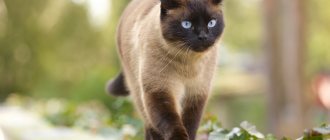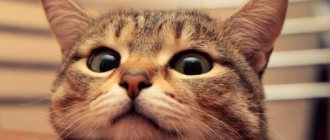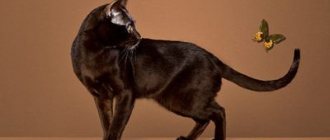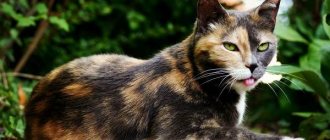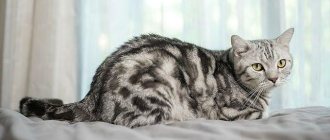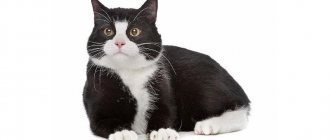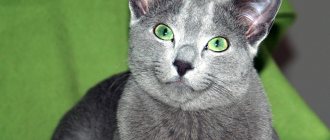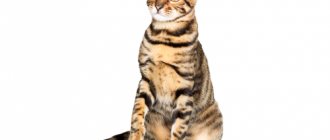Scottish Blue Point cats
The color of blue point Scottish cats (translated from English as “blue-point” means “blue dot”) is very beautiful. These are completely unique shades of light fur - the main color and shading on the paws, muzzle, ears and tail. Many people want to get just such a cat, because she is fabulously cute.
In the photo: Scottish Fold Blue Point
In the photo: Scottish Straight blue point color
The blue point color is associated with the phenomenon of acromelanism - the dependence of the intensity of coat coloring on temperature: in places where the body temperature is higher, the coat is lighter, and vice versa. While colorful kittens are in the mother’s belly, they are completely light, because their body temperature is uniform. But within a few days after birth, Scottish Blue Point kittens begin to darken their paws, tail, face and ears due to the fact that the temperature of these parts of the body is lower than the rest. This effect is associated with the action of the enzyme tyrosinase, which is responsible for the synthesis of pigments. By the way, for the same reason, colorful cats can change color slightly depending on the air temperature - sometimes darker, sometimes lighter. In addition, this color changes with age.
The color gene in cats determines not only the color of the coat, but also the eyes, which remain blue without changing to golden in adulthood. Blue eyes are the dream of almost every cat owner. And the main thing is that in this case the blue-eyed gene is not associated with deafness, as happens in pure white murkies. As a result, we have unique shades of eyes and fur, which, as a rule, are liked by absolutely everyone, even those who can’t stand Chocleate Point cats (“chocolate point”), which are associated with Siamese and create the impression that they stuck their muzzle in chocolate.
Anomalies and features inherent in the British Bluepoint
The term color point is translated as colored dots (marks). The color of a cat's fur and iris is determined by the presence of a special coloring pigment (melanin), which is synthesized under the influence of tyrosinase (a copper-containing enzyme) from the amino acid tyrosine. The production of the enzyme is supervised by the C (Color) gene. When this gene is mutated, which is now designated by the symbol c, tyrosinase is not produced and, as a result, the dark coloring substance (melanin pigment) is not produced. The animal turns out to be colorless and uncolored - an albino.
Albino cats are often deaf
The Siamese gene (cs) is formed in a similar way, when the main gene C is damaged. The only difference is that the enzyme that oxidizes the amino acid acquires thermosensitive properties. It is activated and produces melanin only at certain low temperatures; at higher temperatures it does not manifest itself at all. This phenomenon is scientifically called acromelanism.
Acromelanism is a genetically determined temperature-dependent type of pigmentation with full manifestation only on the limbs, ears, tail and muzzle and with lighter colored fur on the body. It is found in Siamese and Himalayan cats, rabbits, rats and other species of domesticated animals. It is a form of albinism.
This is how the Siamese thermal effect is obtained, when the peripheral remote (cold) areas of the body with a slightly lower temperature are colored. At the same time, the pigment is almost not synthesized in the remaining warmer areas of the animal’s body. The Blue Point cat is actually gray (blue), but its color appears only on the ears, face, tail and paws.
The Siamese color can appear in varying degrees of intensity.
Newborn kittens are light, almost white, because it is warm in the womb of the mother cat, the temperature is the same and melanin is not produced. The point coloration in babies does not develop immediately. First the tail darkens, then little by little the ears, and only then the nose and paws. The mask on the face is the last to darken; during the first two months of life, only one nose of the kitten may be colored. Points begin to appear literally a few hours after birth and are finally formed only by a year, or even later.
Pointed kittens are always born completely white.
It has been noted that all pointing cats are prone to general darkening with age, while maintaining an obvious contrast between body tone and marking color.
We live in a private house and by the color of our Siamese cat we can safely judge the current time of year. In the summer, when it is warm and she often walks outside, her fur becomes lighter and even the dark areas on her face, paws and tail become less bright. In winter, the pet gets very dark, because the floor is cold, and that is where she most often lives, although she tries to lead a sofa lifestyle.
Video: cats and genes
Blue point color standard
A straight-eared or fold-eared Blue Point Scottish cat should have a blue mask on its face and the same markings on its ears, paws and tail. The rest of the body is almost white: without markings or patterns, blurred spots and yellow tones. All this is considered a disadvantage.
A good point color that will last a lifetime is quite difficult to obtain. Small kittens often have high-quality coloring that matches the standard, but as they grow older, the body may darken, which is a big disadvantage.
The ideal point color works well when both parents of the kitten are also points, and not in the first generation. Conversely, there is a greater chance of getting a darkened body if the parents were of a different color, for example, solid (solid).
The eyes of a blue point cat, as we have already said, are blue. The darker, more saturated, “deeper” the color, the better. Cats with light eyes (and often they are not at all expressed, grayish) are valued less.
Colories with decent eye color often have disgusting coat texture and a rustic appearance. The British often have weak bones, the Scots have short, problematic tails and ears that are not laid back well enough. These disadvantages are related to similar problems with shaded colors, which are most often used to produce color points. Yes, there are already some British people with decent hair and decent type, but there are only a few of them. As well as in the colorful colors worthy of the Scottish ones, there are only a few. British colors, obtained from blue, lilac, and patterned animals, most often have good bone and coat. In some places there is even a good contrast, but for the most part they have an extremely pale eye color. Scottish breeds bred from colored stock are also pale-eyed. They have a positive chance only if they are obtained from stable lines imported at different times from the USA and Canada. Local stock bred from the British will produce British-like variants with all the characteristic nuances.
A Brief History of Breeding Cat Colors
Initially, all cats had variegated colors, which allowed the animals to remain unnoticed in the forest. Human intervention has made their color, by which we mean the color of the coat and various patterns on the skin (stains, all kinds of spots, stripes, etc.), extremely diverse. As a result of crossing individuals with certain characteristics, offspring of the desired color appeared. To consolidate the result obtained, only these animals were used in future breeding work; all others were excluded from the breeding process.
There are a lot of colors of cats bred
Blue point color genetics
Point belongs to the black series of colors, because, from the point of view of genetics, blue is nothing more than a diluted, or rather rearranged, black pigment. But blue coat genes B (black series) and d (dilution gene) alone are not enough to get a point kitten. A couple more recessive cs genes are needed, which displace the pigment into the marking area.
The ancestors of the Points are Siamese cats, which is why the color is also called Siamese. In Thailand it is considered sacred because... he was taken out by the monks in the monastery.
Today, among Scottish cats, the color gene cannot be called so rare, but breeders often value its carriers higher than solid blue cats. There are even entire nurseries that specialize in the reproduction of Point cats.
You can get a point cat even if both parents, for example, are gray (that’s what people call them, although they are actually blue). The main thing is that they are carriers of the desired gene. But even if they carry this gene, the chance of having a colored kitten is 25%. It happens that the color gene appears after 2-3 generations. For example, the kitten’s great-grandparents were colorful, but the gene did not manifest itself in the form of color in the parents. At the same time, two color point parents cannot produce a kitten of a color other than color point.
The international designation for the blue point color is a33.
Strabismus in point cats
Cats of any point color (and there are not only blue, but also seal point, lilac point, lynx point and other variations) can experience convergent strabismus, which is characteristic of cats of the Siamese, Thai, Oriental and Burmese breeds. This defect, geneticists believe, is a byproduct of the action of the cs point gene.
Often in point cats you can find a violation of the projection of the optic nerves: part of the visual pathways from the eye goes to the side of the brain opposite to the norm. To compensate for this feature, strabismus appears, which allows the cat to build the correct visual picture.
Blue point color and character
There is an opinion (not a proven fact) that the Blue Point Scotsman is a cat with character. The fact is that the blue colors of the Scots were originally obtained from British cats, known for their temper. Modern Scottish Folds and Blue Point Scottish Straights are somewhat similar in character to the British: they are independent, willful, and can be aggressive if they don’t like something. However, the degree of expression of these qualities depends on the presence of British cats in the immediate family. If there are a lot of British people in the document, you should expect a tougher character, and vice versa. However, British genes will still be softened by Scottish ones, so such cats are more sociable and kinder than their British counterparts.
Caring for point cats
In general, care for point cats is the same as for cats of other colors. But it has its own characteristics.
Point cats cannot be cut or shaved: this leads to the appearance of darker areas of the coat. In the photo below you see the “panties” of a point cat, which formed after shaving before sterilization. This feature of this color, of course, does not mean that a Point cat cannot be operated on: a mark on the stomach does not make the animal less beautiful, because it is practically invisible. But, if you trim your cat's entire hair or in prominent places, or shave it, this can cause it to become dark throughout the body, and this will ruin its appearance.
Inept use of a fruminator when combing can also lead to bad consequences, because... With this tool it is easy to damage and cut off hairs, resulting in the undesirable effect of darkening the fur. If you do not know how to use a furminator, it is better to opt for a special paw for combing cats.
Also, the color of the point, as we said above, reacts to the ambient temperature: the lower it is, the darker the marks, and vice versa - in the heat, many cats become significantly lighter. Accordingly, don’t be surprised if your cat looks a little different depending on the time of year. The ideal temperature for keeping points is +25 degrees.
It is worth considering that the blue point color is a light color, and therefore easily soiled: dust and dirt in the house, settling on the fur, will spoil the appearance of the cat. Even if she is washed regularly, you will notice that the color becomes more interesting after a bath. This statement is not a call to endlessly bathe your pet, but advice on how you can improve the color if you suddenly notice that it has worsened. If the cause was contamination, advice will help. Although there are many other reasons for the deterioration of color point colors.
To improve the color, you can bathe Blue Point cats whose bodies are not light enough with special lightening shampoos. However, if the cat’s markings, on the contrary, are weakly expressed, then there is no need to lighten the fur further. Then you can choose any shampoo based on the problem (if any) or a basic one. We are talking about professional shampoos. It is better to avoid mass-market shampoos.
Some owners notice that food also affects the color of Blue Points: beef, carrots, beets, liver and seaweed can darken the coat. However, this has not been scientifically proven, and along with the owners who noticed changes in color depending on the diet, there are those who do not see any changes.
In the end, we would like to add that the point color of Scottish and British cats is one of the most unstudied: probably, its quality is influenced by a greater number of genes than is currently known to felinologists. So far, among the British and Scots, standard-colored point cats that have retained the excellent morphological characteristics inherent in these breeds are a rarity. The point colors within these breeds will still undergo changes: breeders have a lot of work ahead of them.
Source
Features of keeping and caring for the British Blue Point
The original heat-dependent point color imposes some restrictions on the living conditions of such cats. First of all, it is extremely important to maintain the optimal temperature in the room; it should be between 25–28 °C. When there is a sharp cold snap, the cat’s coat darkens; in extremely warm temperature conditions, the marks lighten and become almost invisible.
Some foods negatively affect the color of the coat, causing it to darken or yellow:
- seaweed and any seafood containing high amounts of iodine;
- carrots (raw and boiled);
- buckwheat grain;
- beef;
- liver and other foods rich in copper.
It is better to feed British Blue Point cats with special food for Siamese cats
You should be extremely careful when giving your color-point pet vitamin complexes and ready-made store-bought foods with kelp, as well as those enriched with microelements (I, Cu).
If a predisposition to color changes is noticed, then it is better to opt for specialized food for Siamese cats.
If possible, traumatic damage to the skin and operations should be avoided, since the hair on the damaged area of the skin grows much darker than on the rest of the body. The scarred tissue is colder, which provokes the synthesis of the coloring melanin. This is why pointing cats always have their nails trimmed in a timely manner (at least once every 2-3 weeks) and their ears cleaned (at least once a week). A restless, itchy cat may very well scratch itself. The appearance of scratches is extremely undesirable. Sometimes the color is restored after another moult, but this does not always happen.
Particular attention is paid to the care of the coat (applies to long-haired Britons), which must be thoroughly combed daily. The resulting tangles on a neglected animal will have to be cut off, and the newly grown coat will be darker.
If pointing cats are not kept correctly, their fur will darken.
After a sterilization operation, our Siamese cat developed two dark spots on her stomach, exactly where the incisions were. Moreover, light, almost snow-white areas appeared near them. Almost two years have passed and the color has not recovered.
The rest of the care is standard and consists of the following procedures:
- brushing your teeth (every 5–7 days);
- rubbing eyes (daily);
- bathing using special shampoos (1–2 times a year);
- vaccination (annually);
- prevention of parasites: against worms - suspensions, tablets, etc.;
- for fleas - collars, drops on the withers, shampoos, etc.
What to feed a Scottish kitten?
Scottish cats are very fluffy and cute, many people dream of having such a pet. Their skin comes in different colors, from marbled to point. Scottish Straights (straight-eared Scots) originated in Scotland, as can be understood from the name. Only recently has the breed gained independence, because there is also a fold-eared variety. Such a kitty will bring a lot of positivity and joy to any home. She will get along well with small children, will not bite or scratch them, will gladly take part in games and fun, and when she gets tired, she will simply hide in her house. By the way, she needs a house - it is important that the animal has a place where it can retire and be in peace and quiet, without communicating with anyone and gaining strength.
Description
These animals have the following appearance features:
- weight about five kilograms for boys and three and a half for girls,
- rounded head shape,
- elongated graceful body,
- graceful plastic movements, mobility,
- forehead is convex, high, rounded,
- eyes wide apart, open, large, expressive,
- round muzzle, developed chin,
- Medium length and width of the paw, harmoniously combined with the body,
- the tail can be long and very long, tapering at the tip,
- The nose can be either medium or short. It is wide and with a recess,
- very soft, thick undercoat, hair does not fit tightly to the body,
- fur can be both short and long,
- The ears are small or medium-sized, rounded at the tips and wide at the base.
Briefly about the British breed
The British cat breed is considered one of the most ancient; the first mentions of domesticated cats and their images, visually reminiscent of modern Britons, are found in handwritten books of the 7th-8th centuries. However, the breed was officially recognized only at the end of the last century.
British cats became especially popular in the 19th century
Cats of the British breed are distinguished by a large, massive and slightly squat physique . The average weight of males is usually about 7–8 kg, but sometimes individual individuals can reach 10 kg. Females are rarely heavier than 6 kg; they are considerably smaller and more graceful. The British have a muscular, stocky, harmoniously sculpted body with a wide sternum, a massive shoulder girdle and back, as well as strong, thick, slightly short legs. The forehead-shaped, round head with large eyes and wide-set ears is firmly set on a short but strongly developed neck. The chin is well defined, the nose is short and quite wide, and the whiskers are clearly visible on the voluminous cheeks. The tail is of medium length, proportional to the entire body of the animal, thick at the base, tapering towards a rounded tip.
British cats have a massive and strong build.
A purebred Briton is always distinguished by a short and very thick soft coat that does not lie close to the body, plush to the touch, with a densely packed, high-quality undercoat.
Determination of color
Color point is a derivative of a combination of two English words: color (color) and point (point). Its visual expression is characterized by the contrasting difference between the light body of the animal and the accentuated ends of the limbs.
The most typical representative of this class is the Siamese breed, from which, apparently, the entire selection line came.
The distinctive features of the color point color appear as follows:
- light monochromatic hair on the body;
- clearly visible darkening on the legs, tail and ears;
- a contrast mask on the muzzle that can spread over its entire surface or be located only in the nose area.
The color of the limbs and its saturation depend on additional reasons.
Interesting: All colorpoint kittens are born without signs of future pigmented areas, but they appear already in the first week of life.
What does the Blue Point color mean?
An unusual coloring called Color Point has long been characteristic only of the Siamese breed. Its main difference is the presence of color only in certain places, the so-called points.
The shade appears only on the tail, ears, paws and nose, the rest of the cat’s body remains white.
At birth, babies are completely white, and only then the tail gradually darkens, then the ears, and lastly the paws become colored and a mask appears on the face.
Character
Such pets have high intelligence, they have an easy-going character, they are self-sufficient and reasonable. They tend to choose one of the family members, whom they consider their master, but they also love the rest very much, but they don’t sit in anyone’s arms. It’s better for the cat to sit next to you and press its side to the person.
Kids easily get used to a new home and other pets; they are quite comfortable with children and older people. They tolerate loneliness well. When everyone is at work, they don’t destroy the house and behave well. These are very obedient animals, they understand well what is possible and what is not. They are active, love to play, but always know when to stop.
Pets almost never use their claws or teeth; if you get too hard on them, they will rather go into a corner and hide there. They cannot stand rude treatment; if you yell at them, they can hide for a long time and not come out, getting offended. If you decide to explain to the purr that he did something wrong, it is better to just speak in a stern voice. This is enough, because he is smart and understands everything.
Thai cat: breed description, standards
Thai cats have a good character. They are unusually smart, easy to train, clean and quite sociable. Like any creature, they have not only good qualities, but also bad ones. If they are treated with respect, they will behave well.
As for appearance, there is a standard:
- The standard is considered to be medium-sized animals, weighing from 5 to 8 kg. They should have a compact, muscular body with a broad chest and be gracefully built.
- In accordance with the World Cat Federation (WCF) standard, the animal's head should be rounded with an extended forward muzzle, similar in appearance to a wedge. The chin should not protrude forward. The norm is round cheeks, not too plump.
- The cat should have a short neck, not a long one.
- The eyes are large, almond or lemon shaped, blue to blue in color.
- The ears are wide and length is medium. The tips of the ears are slightly rounded.
- Legs are strong, with developed muscle mass. The length is average, corresponding to the size of the body. The size of the paws is small and round.
- The length of the tail is commensurate with the proportions of the body.
- The coat is short, thin, without undercoat. It should be slightly adjacent to the skin and feel smooth to the touch. The standard coat color is acromelanic.
Be sure to read:
Colors of Scottish cats: description, features, rare colors of folds
The colors of the “Thais” are varied, as are their shades. They can be plain, striped or spotted. One of the main features of the color is a dark “mask” located on the muzzle. Individuals with a bright contrast of points enjoy great success at the exhibition.
Color Point (Not Siamese)
What breed is this cat? Probably 90% of people who are far from felinology in general and cat breeding in particular will answer without hesitation - Siamese. Is this really so?
Unfortunately, a common mistake of many lies in transferring the name of the color characteristic of the Siamese and Thai breeds to all color-point cats.
What is this color point color and why is it called that?
Siamese cats have a lighter colored body than the protruding parts of the body - the points (muzzle, ears, paws and tail), which are more intensely colored. Therefore, this color is called “point”, that is, terminal.
Color point belongs to the group of acromelanic colors. Acromelanism is a phenomenon of incomplete albinism, when the intensity of coat coloring depends on temperature (!) - less pigment is produced in warm parts of the body than in cold ones, that is, on the ears, muzzle, paws and tail, which will be colored darker.
These individuals do not require special conditions and are very easy to maintain. They live well in apartments and do not need much space. When leaving home, be sure to leave your pet toys, food and water. Then he will survive this time well. Grooming for Scots is standard; you need to regularly trim their nails, wash their eyes, clean their ears, and comb out their fur. The latter should be done about once or twice a week, bathing rarely, as it gets dirty.
It is very important to love your pet and show him that he is important. In this case, he will feel great and live a long and happy life. Don't forget to monitor his health and give him medications for worms and fleas. Even a pet can become infected with them. If you plan to take him outside, it is better to get a harness to control his movement. He tolerates travel and travel very well and feels comfortable in the car.
color-point groups
The activity of the point color gene is activated when it is present in two sires. Scientific research has revealed that individuals of this color are partly albinos. At birth they have a snow-white coat color, which later turns into color point. In the first month of life, the ears darken, a month later - the nose, and then the entire muzzle. Dark spots should be intense, contrasting relative to the body.
Color changes when exposed to heat or cold. To maintain purity and uniformity of color, such animals require warm conditions.
Scottish Straight SFS 71 b 33
British longhair ny 21 33 03
Solid colors
Solid color point varieties are widespread among furry representatives of the British breed. Owners of the classic color point have a very light body framed by areas of the main color.
The fur is short, with a dense structure. The correct color is contrasting, the hairs in dark areas are evenly colored. The color of the point marks is clear, intense, no blurring, no dyed white hairs. The point markings, nose, and pads on the limbs are characterized by a single color.
British shorthair red point BRI d 33
Blue-eyed Lilac-point cat BRI c 33
Offspring with a solid color point in British and Scottish cats can only be obtained from sires with this coat color or from carriers of the corresponding gene. It is also important for older ancestors to be solid color point or have a gene for this color in their genotype and the ancestors of both parents should have it. As mentioned earlier, newborn kittens do not have point markings. Darkening appears on the limbs, tail, ears, and muzzle later. It is interesting that the intensity of the shade of point marks in British cats depends on their age; in more mature individuals, the color is more saturated in tone.
Scottish straight blue point cat SFS 71 a 33
Scottish fold cat with blue eyes SFS c 33
The varieties are shown in the table.
| A variety of solid point | BRI code | Body tone | Point marks | Eyes | Tone of paw pads, nose mirrors |
| Black | seal point | Seal-point | n 33 | Warm white, light beige, beige, cream | Dark brown | Light blue, blue | Dark brown |
| Blue | blue point | Blue-point | a 33 | From cool white to bluish gray | Blue | Light blue, blue | Gray-blue |
| Cream | Cream-point | e 33 | White with a slight milky tint | Cream | Light blue, blue | Beige coral |
| Lilac | lilac point | Lilac-point | c 33 | Almost white, sometimes with a purple tint | Gray pink | Light blue, blue | Gray pink |
| Red | red point | Red-point | d 33 | White with pink or apricot tint | Orange or red | Light blue, blue | From red to coral |
| Chocolate | chokelit point | Chocolate-point | b 33 | Ivory | Chestnut brown | Light blue, blue | Chestnut brown |
| Faun | Fawn-point | p 33 | Light sand | Warm brown with beige tint | Light blue, blue | Pink sand |
| Cinnamon | Cinnamon-point | o 33 | Ivory | Bright brown with a red tint | Light blue, blue | Pink brown |
Scottish cat SFS 71 b 33
Scottish Fold Shorthair SFS n 33
The main thing for a black point is a clear contrast between the shade of the body and the point markings. The points will be almost black if the body is dark and light if the body is white.
Cream Points have very little contrast between the cream-colored point markings and the lightened, milky body. In such a situation, it is important to observe the color of the eyes, which, according to the rules, should look bright and intense. In addition, the British Cream Point coat has a residual pattern, which is a genetic feature of this color. The formation of color is completed by one to one and a half years.
Red color-points among British cats have the same characteristics. They are distinguished by the presence of a residual pattern on the coat; the final shade will be formed by one to one and a half years.
The body color and point markings of the British lilac-point do not contrast strongly with each other, but there is a pronounced, clear transition.
Tabby point | BRI x 21 33
This color is notable for the presence of a tabby pattern on the points. Its color refers to the main or one of the tones of the mosaic. Markings cover the frontal part of the head (the letter “M”), the area around the antennae, and the eyes.
On the very light body the pattern is absent, but appears on the forelimbs as torn rings and stripes on the thighs. The ear is marked on the outside with a light spot.
BRI from 21 33 lilac-tubby-point
The paw pads and nose are colored the same color as the markings. Tabby points correspond to codes 22, 23 and 24 (marble, tiger and spot, respectively).
Links | lynx are designated with a single code 21, regardless of the tabby variety.
Therefore, to indicate a specific color, it is customary to add the number 21 to the code. For example, seal tabby point will be designated as BRI n 21 33, seal tortie tabby point – BRI f 21 33...
Color point with white
This is a complex color. Its representatives must meet the standards of two colors: color point and bicolor. The tail, ears and paws (as a rule, only the hind legs) are characterized by darkening, but the cheeks in the area of the mustache and nose are often spotted, with white spots. The front legs are almost always white. Half to a third of the cat’s body is also covered with the same color.
The British with this color have eyes of a standard shade - sky blue or blue. The shade of the nose and paw pads is according to the standard.
Kitten blue golden tabby point with white BRI ay 21 33 03
Long-haired kitten chocolate golden tabby point harlequin BLH by 21 33 02
To breed color-point bicolor offspring, you need a pair of cats of the same color or carriers of the gene. The parents' pedigree must contain pointing, white-haired Britons. Colorpoint British kittens are born without point markings. Dark areas appear as babies grow.
BLH cy 11 33 03
There are the following combinations of shades among the British:
| BRI code | X ‒ point bicolor | X - point with white |
| n 03 33 | seal | black |
| a 03 33 | blue | blue |
| b 03 33 | chocolate | chocolate |
| from 03 33 | lilac | lilac |
| d 03 33 | red | red |
| e 03 33 | cream | cream | cream |
| p03 33 | fawn | faun |
| o 03 33 | cinnamon | cinnamon |
BLH ny 21 33 03
Highland fold SFL n 21 33 03
BSH bs 21 33 03
lilac gold shaded point with white cy 11 33 03
Smoky color point | BRI xs 21 33
British, Scots with this mixed shade must comply with the standards of smoky color, color point. These cats have a white undercoat under light hairs, a darkened tail, paws, muzzle, and ears, and the ears seem to be sprinkled with silver. The presence of a tabby pattern on the coat is rejected. British shorthair and longhair cats of similar color have blue eyes, and the pads on their paws, nose and point markings are the same color.
BRI as 21 33
BSH cs 21 33
Darkened areas of the body in British people with smoky color point:
| BRI code | X smoky color point |
| ns 21 33 | black |
| as 21 33 | blue |
| bs 21 33 | chocolate |
| cs 21 33 | lilac |
| ds 21 33 | red |
| es 21 33 | cream | cream |
| PS 21 33 | faun |
| os 21 33 | cinnamon |
as 21 33
BRI as 2133
Torty Point | tortie point | tortoiseshell point
Another variety of mixed colorpoints among the British is the tortoiseshell. The body of the animal is tinted in a light color, while the points are painted in the basic color with a tortoiseshell mosaic. The presence of large and distinct black and red spots is a defect.
It is rare to see a tortie point. It is possible to breed this shade of fur from the offspring when one of the parents is tortoiseshell and the other is a color point.
BRI f 33 03 black tortoiseshell point bicolor
British longhaired chocolate tortoiseshell point bicolor BLH h 33 03
Possible color combinations for the British tortie point:
| BRI code | X tortoise point |
| r 33 | fawn-cream |
| j 33 | lilac-cream |
| g 33 | blue-cream |
| q 33 | cinnamon-red |
| h 33 | chocolate red |
| f 33 | black-red |
Shaded Point | shaded color point
The base shade of the British coat can be golden or silver. At the same time, the third part of the hairs in the tipping on the back is made in the main color. From color point, representatives of this color have a darkened tail, ears and muzzle. The rim around the nose is painted in the main color, as is the outline around the sky blue eyes. The eyes are surrounded around the perimeter by white fur. The color of the pads on the limbs corresponds to the color. The presence of tabby marks is a defect.
BLH by 11 33
BLH ny 11 (25) 33
Color combinations of shaded color point:
| BRI code | X shaded point | Description |
| as 1133 | blue silver | Silver base with blue tipping and markings. The nose is pink, the rims of the eyes and nose, and the eyes themselves are blue. |
| ay 1133 | blue gold | The base is gold, blue shading and blue point color. The nose is pink, the eyes are blue, and there is a dark blue rim around them. |
| ns 1133 | black silver | This Briton has a main shade of silver with black points. Pinkish nose and blue eyes with black edging. The color of the pads on the paws is black. |
| NY 1133 | black gold | This color combines golden shading with black pointing. There is a black rim around the blue eyes. The nose is pink with a black border around it. |
BLH n 11 33
Chinchilla Point | veiled color point
The main tone of veiled British cats can be either gold or silver. Tipping fur is ⅛ of the main color, usually black. There is darkening of the tail, ears, and muzzle. The outline of the nasal mirror and the eyes are colored in the main tone. The eyes are blue with snow-white fur around the perimeter. The color scheme of the paw pads corresponds to color point standards. The tabby pattern is considered a breed culling.
Colors of veiled color point:
| BRI code | X veiled point |
| PS 1233 | faun silver |
| OS 1233 | silver cinnamon |
| bs 1233 | chocolate silver |
| cs 1233 | lilac silver |
| ay 1233 | blue golden |
| as 1233 | blue silver |
| NY 1233 | black golden |
| ns 1233 | black silver |
BRI ny 12 33
In order for British kittens to inherit the color point color, you need to breed two cats of the same color, or a pair of carriers of the corresponding gene. At birth, the offspring do not have point marks; as the animal grows, the paws, ears, muzzle and tail darken.
Caring for a cat with point colors
Experienced breeders recommend paying special attention to cats with this color. The optimal air temperature is 25-28 degrees. When it sharply decreases, the fur will darken; when it increases, the marks will become lighter.
It is not advisable to add foods containing iodine and copper to your diet.
Thai cat with point colors
Long-haired cats need to be brushed daily. If matted hair has to be cut, darker hair will grow in its place.
Blue point cats, which appeared not so long ago, quickly won the love of breeders for their unusually beautiful colors. Those wishing to purchase a kitten of this noble shade have a choice of breeds and variations.
Caring for a Blue Point pet is not much more difficult than caring for any other cat.
If you decide to buy a baby with blue markings, I wish you good luck in raising him and joy in your future life with him.
Yes, the Scottish Fold is not the most capricious breed; they are quite independent and can be alone for some time without hysterics. They do not accept excessive activity on the part of humans, shy away from overly intrusive children and do not welcome fuss and noise.
We suggest you read: Choosing food for Scottish Fold
They love to be around people. They enjoy watching everything that happens in the house. They can follow on your heels, but not give in to your hands.
Point colors of the Scottish Straight cat
This color is often called “Siamese” by cat lovers. The main characteristic of the Point is that the legs, tail, ears and muzzle are darker than the main coat. The following variations are allowed:
- Blue point - as the name implies, there are blue marks in the areas indicated above. It is preferable that the blue is not very dark. The main coat is white.
- Cream point is a completely cream color. Only the main part of the fur coat is painted in a lighter shade, and individual parts are painted in a darker shade.
- Cream Blue Point is a rather interesting variation, in which the body is grayish-cream, and the muzzle, paws, ears and tail are dark gray.
- Lilac Point – there are purple markings on the snow coat.
- Chocleate Point is a very beautiful color, in which specks of a rich chocolate palette adorn the snowy coat.
- Chocolate Smoke Point – a whole scattering of chocolate! The main surface of the fur coat shimmers with a light variation of brown, and the remaining necessary areas are dark.
- Red point - the white cover is marked with red areas.
- Tortie point - in simple words, it is a tortoiseshell color mixed with cream or red spots.
- Tabby point - light coat marked with striped areas in the right places.
Whatever the point variant, the eyes should in any case be colored blue.
These cats are extremely careful and reasonable. Cleanliness is also their calling card.
Variations
In addition to the classic blue point, today there are several more variants of this shade:
- In Blue Tabby Point , the markings on the paws and face are not uniform, but striped (tabby). On the forehead the stripes form the letter M.
- The Blue Ticked Point is a recent development and is very rare. It originated from Abyssinian cats and is distinguished by the fact that a ripple effect is visually created on the body, making the fur look like the skin of a rabbit or chinchilla.
- In the Blue Cream Point , blue-gray markings are evenly mixed with cream. The nose can be either dark or pink.
- The blue tortie point has a tri-color tortoiseshell pattern. This is a chameleon color that changes its appearance throughout its life. Each cat of this shade is unique due to the arrangement of bluish-cream markings.
Blue cake point
British cat Blue Point BRI a 33: color standard
The body of a British Blue Point cat should be very light, from cold white to gray-bluish. The point markings should be blue.
In this color it is important to maintain contrast, since the blue tone itself is quite light, so when mating it is important to choose the right partner in order to maintain the richness of the point marks.
The eye color of British Blue Point cats is blue or blue, but again you need to monitor the brightness and intensity of the blue eye color in order to maintain contrast.
The nose and paw pads are gray-blue.
With age, Blue Point British cats gain color and the color becomes more intense, often darkening.
Maintaining the color of a Thai cat during breeding
The Thai breed continues to improve and develop thanks to professional breeders. Animals acquire new colors and become more attractive. The Thai cat matures early. She becomes ready for mating by the age of one year.
To preserve the color of the breed, you must follow the following rules:
- Only by crossing purebred individuals can you get purebred kittens, so you cannot breed a Thai cat with other breeds. It is better to look for a partner in nurseries.
- It is recommended to select a partner based on color. Animals must be the same color.
If whitish spots or dark spots appear on the kittens' fur in the belly area, this will be considered a flaw in the exterior. All eye colors except blue are also considered a deviation.
Features of mating British blue point dogs
The bluepoint color is quite difficult to breed, since the cs gene is recessive (suppressed). Only when both producers (male and female) have such pigment colors, the kittens in the litter will be guaranteed to be pointing only. Parents with smooth, monochromatic hair who are carriers of the cs gene can also produce children with Siamese pigmentation, but with a 25% chance. If a Blue Point female or male is bred with a carrier of the gene, half of the kittens are born white and then acquire the characteristic blue markings.
Source
